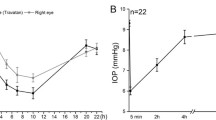Abstract
The effects of timolol maleate on intraocular pressure (IOP) and the severity of retinopathy induced by exposure to 80% oxygen were studied in newborn Wistar rats. One drop of timolol maleate (0.25%) instilled in each eye twice a day for the first ten days of life substantially reduced intraocular pressure without significantly modifying arterial pressure. Forty percent of the ratlings treated in this way failed to develop oxygen-induced retinopathy (OIR) after exposure to 80% oxygen for the first five days of life; in the other 60% OIR was less severe than that seen in an identically oxygenated group that did not receive timolol. The authors hypothesize that the pharmacologically induced reduction in IOP may have attenuated the effects of the high concentrations of oxygen on the immature retinal vessels by improving the ocular perfusion pressure. The possibility that timolol maleate also exerts a direct action on the caliber of these vessels cannot be excluded.
Similar content being viewed by others
Abbreviations
- BP:
-
blood pressure
- OIR:
-
oxygen-induced retinopathy
References
Silverman WA. Epochè in retinopathy of prematurity. Arch Dis Childh 1986; 61: 522–525.
Lucey JF, Dangman B. A reexamination of the role of oxygen in retrolental fibroplasia. Pediatrics 1984; 73: 82–96.
Fletcher MC, Brandon S. Myopia of prematurity. Am J Ophthal 1955; 40: 474–481.
Ricci B. Effects of hyperbaric, normobaric and hypobaric oxygen supplementation on retinal vessels in newborn rats: a preliminary study. Exp Eye Res 1987; 44: 459–466.
Ricci B, Calogero G. Oxygen-induced retinopathy in newborn rats: effects of prolonged normobaric and hyperbaric oxygen supplementation. Pediatrics 1988; 82: 193–198.
Funk R, Rohen JW, Skolasinska K. Intraocular pressure and systemic blood pressure after administration of vasoactive substances in hypertensive and normal rats. Graefe's Arch Clin Exp Ophthal 1985; 223: 145–149.
Patel S, Meldrum BS, Fine A. Susceptibility to pilocarpine-induced seizures in rats increases with age. Behav Brain Res 1988; 31: 165–167.
Ernest JT, Goldstick TK. Retinal oxygen tension and oxygen reactivity in retinopathy of prematurity in kittens. Invest Ophthal Vis Sci 1984; 25: 1129–1134.
Flower RW, Blake DA. Retrolental fibroplasia: evidence for a role of the prostaglandin cascade in the pathogenesis of oxygen-induced retinopathy in the newborn beagle. Pediat Res 1981; 15: 1293–1302.
Grunwald JE. Effect of topical timolol on the human retinal circulation. Invest Ophthal Vis Sci 1986; 27: 1713–1719.
Martin XD, Rabineau PA. Vasoconstrictive effect of topical timolol on human retinal arteries. Graefe's Arch Clin Exp Ophthal 1989; 227: 526–530.
Phelps DL. Reduced severity of oxygen-induced retinopathy in kittens recovered in 28% oxygen. Pediat Res 1988; 24: 106–109.
Lucey JF, Horbar JD, Onishi MJ. Cerebral and retinal hypoperfusion as a possible cause of retrolental fibroplasia: Hypothesis to explain non-O2 related RLF. Pediat Res 1981; 15: 670.
Author information
Authors and Affiliations
Rights and permissions
About this article
Cite this article
Ricci, B., Calogero, G., Caprilli, A. et al. Reduced severity of oxygen-induced retinopathy in the newborn rat after topical administration of timolol maleate. Doc Ophthalmol 77, 47–56 (1991). https://doi.org/10.1007/BF00154877
Accepted:
Issue Date:
DOI: https://doi.org/10.1007/BF00154877




